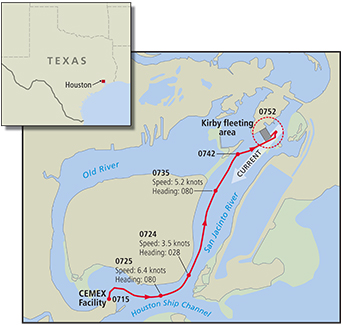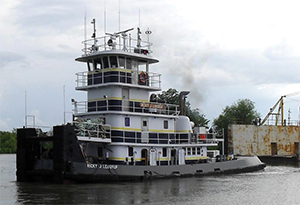The relief captain aboard Ricky J Leboeuf took the controls from the steersman as the towboat approached a San Jacinto River fleeting area. The river was fast and high, and he wanted to show the right way to downstream into a barge.
The vessel didn’t land flush against the barge, and the fast-moving current spun it sideways against the fleet. Water rushed into the towboat and it sank about two minutes after impact. Four crew escaped but a deck hand died. The victim was identified as Joshua S. Brazeal, 33, of Brookwood, Ala.
The incident occurred at 0752 on April 19, 2016, near Channelview, Texas, while the San Jacinto River was at 15 feet — 5 feet above flood stage.
The National Transportation Safety Board (NTSB) determined the probable cause stemmed from “the relief captain’s ill-advised decision to perform a downstreaming maneuver in high-water conditions without implementing the operating company’s risk mitigation strategies or other safeguards.” Taira Lynn Marine Ltd. No. 7 owned the 1,800-hp Ricky J Leboeuf and D&S Marine Service of Gray, La., operated the twin-screw vessel.
D&S Marine staff found errors in an initial NTSB accident report released in late January and notified the investigator, company Vice President Julian Murphy said. The NTSB released a corrected report on Feb. 10. Murphy declined to comment on the corrected report, and an agency spokesman would not discuss what changed in the revised version.
More than 5 inches of rain fell in Greater Houston on the day before the accident, and the river current was running at 3.5 knots on the morning of the sinking. Weather conditions were warm and clear with light winds.
Ricky J Leboeuf got underway at about 0715 on April 19 and headed about 2.5 miles to a fleet with roughly 20 barges. It was scheduled to pick up two empty tank barges and transport them to Beaumont, Texas.
Crew noticed the fast current as the towboat entered the San Jacinto. The relief captain took the controls from a senior tankerman/steersman at 0746 and steered the boat upstream of the barge fleet, then turned to port to begin the downstreaming maneuver. Ricky J Leboeuf was making about 1.6 knots with a heading of 212 degrees when its port push knee landed on the barge at about 0750, the NTSB report said.
The relief captain applied power from the twin Caterpillar D379 diesels and used rudders and flanking rudders, but couldn’t square off against the barge. The fast-moving current pushed against the towboat’s starboard side and it spun against the fleet.
 |
|
Pinned against a barge while downstreaming, Ricky J Leboeuf heeled to starboard, then flooded when water rapidly entered the towboat through two open doors on the main deck. |
|
Courtesy NTSB and D&S Marine Service/Pat Rossi illustration |
“At 0752, the force of the river current acting on the Ricky J Leboeuf’s starboard-side hull, combined with the force applied above the waterline on the vessel’s port side from its contact with the stationary barges, caused the vessel to heel to starboard,” the NTSB said. “Water then rapidly entered the vessel through two open doors on the main deck, flooding the hull.”
The senior tankerman jumped onto the barge fleet, and the captain, relief captain and senior tankerman/steersman sought refuge on the port bow gunwale. The towboats Mr. Farrel and Tommy E rescued those three crewmembers.
Brazeal clung to a push knee after the vessel capsized. He tried to swim toward the bow gunwale but did not make it. He was wearing a personal flotation device, although the vest was missing when authorities found his body later that morning.
Downstreaming is a common practice on inland waterways that can be risky during periods of high water or fast currents. The U.S. Coast Guard and American Waterways Operators released a report and accompanying video in 1997 addressing downstreaming dangers and best practices. The video recommends towboats line up with the current rather than the barge fleet in case the fleet is at an angle.
D&S Marine has policies in its safety management system about downstreaming. During certain conditions, captains need approval from a port captain before performing the maneuver. D&S also requires that watertight doors and hatches be shut before starting, among other rules.
Before the accident, Vessel Traffic Services Houston/Galveston issued a warning about the high-water conditions, and D&S Marine sent advisories to Ricky J Leboeuf and other vessels working in Greater Houston. The company advisory placed restrictions on downstreaming and required assist tugs when working in a fleeting area, the report said.
The captain and relief captain aboard Ricky J Leboeuf received the notice and discussed its contents with the crew. They also addressed the risks of downstreaming in high-water conditions. Even so, the relief captain pursued the maneuver “without consulting the vessel’s captain or the company port captain as required by company policy,” the NTSB said.
The relief captain refused to be interviewed by Coast Guard and NTSB investigators, and the report does not explain his decision-making process before the accident.
Crews raised the 54-year-old towboat a week after the incident and moved it to a nearby shipyard. The vessel was written off with damage estimated at $900,000.

